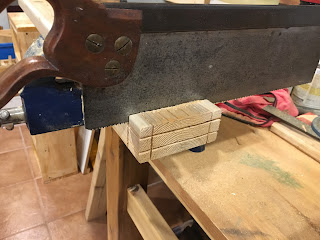This time I used my new Stanley 49 auger bit depth stop instead of a simple piece of tape. I got this one recently and was eager to use it.
 |
| The Stanley 49 depth stop. |
I must admit that I am very pleased with it. At first sight it did not inspired me much but it revealed to be a nice little addition that held well on the bit, is easy to set, and much more precise than a piece of tape.
I applied to the back legs the same recipe as for the front legs, that is to say that I drilled out the mortise waste using the hand brace and then cleaned/chopped the mortise with a chisel. With the back legs the side mortise are located 1/2 inch from the leg side so I needed to be careful when chopping the waste so not to get a split leg.
 |
| Chopping the waste at 1/2" from the side. |
 |
| A bunch of mortised legs. |
Next is to take care of the stretchers. I traced the tenons using a marking knife, then highlighted the mark using a pencil.
 |
| The tenon traced on the stretcher. Note that the tenon is starting from the top of the stretcher. |
I then made a kerf on the waste side using a chisel so to guide the saw blade.
 |
| Kerf to guide the saw blade. |
It takes some time to make these kerfs before sawing but I find it far easier and quicker to have a clean saw cut using this technique. I start with the crosscut of the tenon shoulders, checking to stay square during all the cut.
 |
| Tenon shoulder crosscut. |
 |
| Clean square cut. |
Then follows the rip cut...
 |
| Tenon shoulder rip cut. Note that the waste at the bottom of the tenon is already removed on that picture. |
The result is satisfying for me, I will clean the shoulders with the shoulder plane when I will adjust the tenon to its mortise.
 |
| A freshly cut tenon on the top stretcher... |
 |
| ...and a bunch of them. |
 |
| A hair larger than 1/2 inch. |
Next is to apply the same recipe to the bottom stretchers, so I start with the marked line and kerf...
 |
| Bottom stretchers marked and kerfed. For these ones the tenon is centered. |
...then cut square following the kerf. For these ones I started with the rip cut, followed by the cross cut.
 |
| Rip cutting the tenon... |
 |
| ... then cross cutting to remove the waste. |
After 60 mortises, the 60 tenons were done, next will be to assemble all these, but before that I deserve a cold one!





